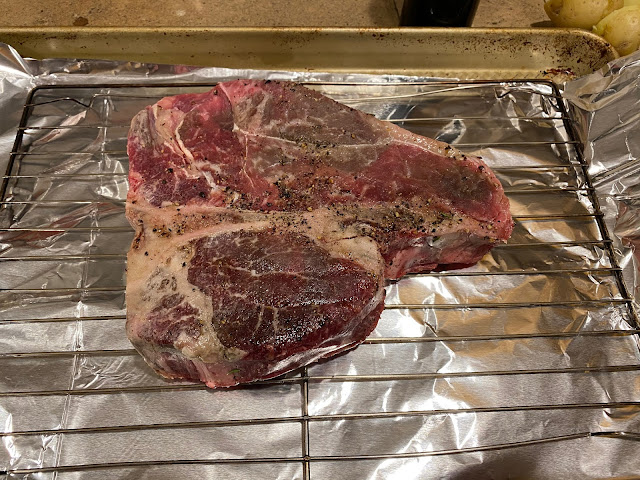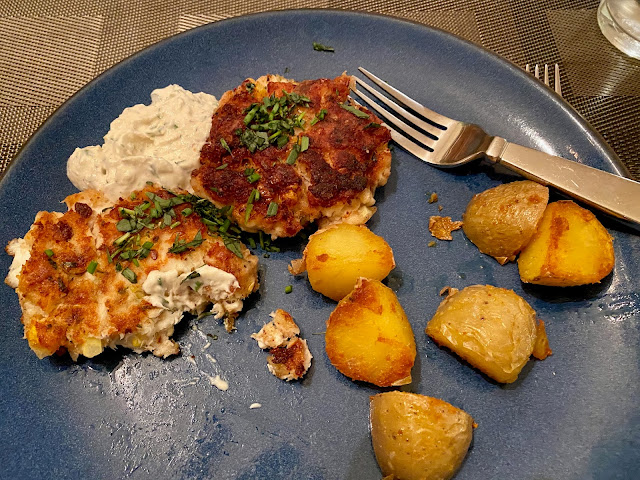With our left over Salmon we made Salmon Burgers and served it with Sushi Rice. It was a great Japanese inspired dinner. The reason we made the seasoned rice is we were trying to replicate the Sushi Rice served with takeout from Majordomo. It is fantastically flavorful. We were close in the flavor of the rice.
Salmon Burgers
The New York Times
For this recipe, you’ll want to grind part of the salmon in a food processor: It’ll bind the rest, which can be coarsely chopped to retain moisture during cooking. Some bread crumbs keep the burger from becoming as densely packed as (bad) meatloaf. This approach, along with a few simple seasonings, produces delicious burgers in not much more time than it takes to make one from ground chuck. The only real trick is to avoid overcooking. Whether you sauté, broil or grill this burger, it's best when the center remains the color of … salmon. Two or three minutes a side usually does the trick.
Ingredients
1-½ pounds skinless, boneless salmon
2 teaspoons Dijon mustard
2 shallots, peeled and cut into chunks
½ cup coarse bread crumbs
1 tablespoon capers, drained
Salt and black pepper
2 tablespoons butter or olive oil
Lemon wedges
Tabasco sauce
Preparation
1. Cut the salmon into large chunks, and put about a quarter of it into the container of a food processor, along with the mustard. Turn the machine on, and let it run — stopping to scrape down the sides if necessary — until the mixture becomes pasty.
2. Add the shallots and the remaining salmon, and pulse the machine on and off until the fish is chopped and well combined with the puree. No piece should be larger than a 1/4 inch or so; be careful not make the mixture too fine.
3. Scrape the mixture into a bowl, and by hand, stir in the bread crumbs, capers and some salt and pepper. Shape into four burgers. (You can cover and refrigerate the burgers for a few hours at this point.)
4. Place the butter or oil in a 12-inch nonstick skillet, and turn the heat to medium-high. When the butter foam subsides or the oil is hot, cook the burgers for 2 to 3 minutes a side, turning once. Alternatively, you can grill them: Let them firm up on the first side, grilling about 4 minutes, before turning over and finishing for just another minute or two. To check for doneness, make a small cut and peek inside. Be careful not to overcook. Serve on a bed of greens or on buns or by themselves, with lemon wedges and Tabasco or any dressing you like.
Vinegar Sushi Rice
Washoku Cookbook
Vinegar-seasoned rice is essential to all sushi recipes. Su meshi (literally, “tart rice") is the word used most often to describe it. At the
sushi bar, though, you may hear rice being called shari, an esoteric
reference to the bones of Buddha that reflects the elevated status
afforded rice in Japanese society.
This recipe can be used to make any sushi dish. The quantity given here is enough to make about four portions.
You can halve or double the recipe for the seasoned vinegar
(sushi su or awase-zuj. It will keep for 1 month in the refrigerator.
Makes 4 Cups Cooked Rice
Seasoned Vinegar
2/3 cup rice vinegar
2 tablespoons sugar
1 teaspoon salt
1 piece kombu, 1 inch square (optional)
4 cups warm, freshly prepared Cooked White Rice
1 Tbl Mirin as MSG substitute (Cathy idea)
To make the seasoned vinegar, combine the vinegar, sugar,
salt, and kombu in a small saucepan. The kombu is optional,
but it will enhance the overall flavor. Place over medium-high
heat and warm, stirring, until the sugar and salt dissolve.
Transfer the warm rice to a handai or a wide, shallow bowl. Avoid an aluminum vessel, because it will retain heat and can give the rice a metallic taste. Using gentle cutting and folding motions, toss the rice with a rice paddle as you fan it with an uchiwa.
When clouds of steam are no longer rising from the rice,
but the rice is still warm, drizzle in some of the seasoned vine-
gar. Start with just a tablespoonful. Continue to use gentle tossing motions and to fan as you season the rice, steadily adding the remaining seasoned rice a few drops at a time. Taste occasionally to verify the seasoning.
It makes an excellent salad dressing when mixed with a few drops of sesame oil.
Cover the seasoned rice in the wooden tub or vessel you mixed in with plastic wrap until ready to use.
























